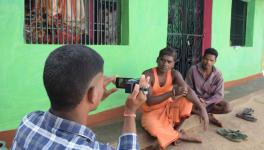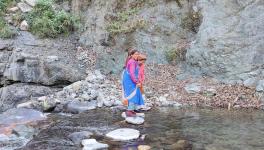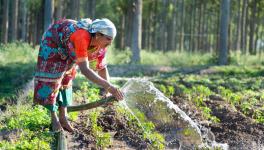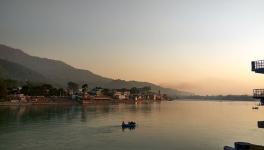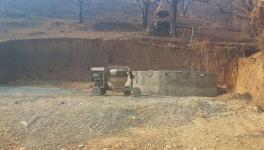Bihar: Poor Main Victims of Climate Change Induced Lightning Strikes
Representational use only.Image Courtesy: NDTV
Patna: Climate change-induced increasing lightning strikes are a big killer in Bihar, and the poor people, mainly landless farm labourers, smallholding farmers, and cattle grazers, are the primary victims. As the poor have been identified as the most vulnerable to climate change impact globally, lightning strikes are killing them more than the rich in Bihar. This factor was revealed by an official report of the state disaster management department (DMD).
Take, for instance, six victims of lightning strikes reported in the Gopalganj, Bhojpur, Saran and Siwan districts on Thursday (July 21). Lightning strikes killed two youths - Abhay Kumar and Mohilal Rai - engaged in a paddy cultivating family in the Bhojpur village. Similarly, in Gopalganj, a middle-aged woman Kusum Devi was killed by lightning strikes when she was busy in paddy transplantation on her farmland. A youth Manu Kumar was killed by lightning when he went to see the paddy farmland of his close relative following heavy rainfall.
According to the DMD's figures so far this year – during the last six and half months – 149 people were killed by lightning strikes in Bihar. More lightning strikes are likely in the coming days because lightning strikes are usually reported during the June-September monsoon season in the state.
As per official figures, in 2021, 280 people were killed by lightning in Bihar. Lightning killed 459 people in Bihar in 2020, 253 in 2019, 139 in 2018,180 in 2017 and 114 in 2016. Going to this official data, lightning strikes killed 1,574 people in the last seven years in the state. It may be less than the floods but one of the highest casualties due to natural calamities, much more than heat and cold waves.
The State government has been providing compensation of Rs 4 lakh to each of the families of the lightning victims.
The DMD's figures highlighted that most of the deaths due to lightning strikes were reported in rural areas compared to urban areas.
It further noted that landless farm labourers, poor farmers and cattle grazers, form the majority of victims of lightning strikes. "This was confirmed by the official data of 2019, 2020, and 2021 as nearly 86% victims were landless farm labourers, poor farmers and cattle grazers," an official of the DMD told NewsClick.
Rajeev, an environment activist, said that poor men and women who are either working in the farmland or outside their houses in the open sky become easy targets of lightning strikes. Sometimes their minor children also become victims while playing outside. “Most labourers working in farmland for water-intensive paddy, a Kharif crop, are poor and landless; they have been taking a risk to earn a livelihood,” he said.
Contrary to the State government's claim of a massive awareness campaign to alert people about how to save them from lightning strikes, ground reality indicates something else. A few years ago, the government launched a mobile app, 'Indravajra', a much-hyped early warning system for lightning strikes. Still, the government agencies have failed to reach out to the most vulnerable section in danger of being struck by lightning.
The app is one of the measures the DMD took to warn people ahead of lightning strikes. DMD officials said the app was helpful as it gives alerts for lightning in the form of alarm bells at least half an hour in advance within a radius of 20 kilometres. The mobile app Indravajra can only be downloaded on smartphones. As a result, poor farmers, farm labourers and cattle grazers do not have the means to access it.
It was evident that merely 1.2 lakh smartphone users have downloaded the app so far, mostly in urban areas.
But the department forgot to take into consideration that poor farmers, farm labourers and cattle grazers, who form the majority of victims of lightning strikes, do not use their smartphones when they are outside their houses. The department officials admitted that most of the victims were at work in paddy fields or grass fields. They were neither informed, alerted or advised not to venture out of their homes.
Besides, the department has installed an early warning system at eight places with the help of US-based Earth Networks. This is expected to provide an advance warning about lightning at particular places.
Bihar has been witnessing an increase in incidents of lightning strikes in the last few years. This is due to the direct impact of climate change. Many studies worldwide pointed out that increasing lightning resulted from global warming, said Abdus Sattar, senior scientist at the Centre for Advanced Studies on Climate Change, Rajendra Prasad Central Agricultural University, Pusa, Samastipur district.
The DMD has been advising people to avoid going outside, particularly in the field, considering the forecast for storms and rain issued by the India Meteorological Department (IMD). The DMD had issued an advertisement in local Hindi dailies on what to do and not to do to protect oneself from lightning strikes. In its advertisement, the department also urged people to download the mobile app 'Indravajra' to access predictions for thunderbolts in their area.
The latest research study by the Delhi-based Centre for Science and Environment (CSE) highlighted that heat waves are the second deadliest natural force in India after lightening.
Get the latest reports & analysis with people's perspective on Protests, movements & deep analytical videos, discussions of the current affairs in your Telegram app. Subscribe to NewsClick's Telegram channel & get Real-Time updates on stories, as they get published on our website.











